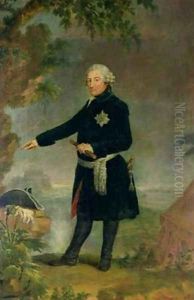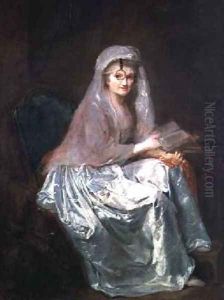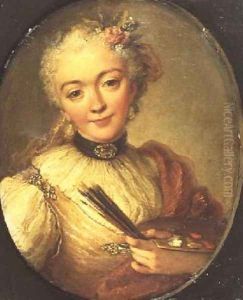Anna Dorothea (Therbusch) Lisiewska Paintings
Anna Dorothea Therbusch (née Lisiewska) was an 18th-century German painter, born in 1721 in Berlin, then part of the Kingdom of Prussia. Coming from a family with strong artistic roots—her father, Georg Lisiewski, and her brother, Christoph Friedrich Reinhold Lisiewski, were also painters—Therbusch developed a keen interest in the arts from a young age. Despite the societal limitations placed on women artists at the time, she pursued her passion with vigor, initially learning the fundamentals of painting from her father and brother.
In 1741, she married a Berlin innkeeper named Ernst Friedrich Therbusch, and for nearly two decades, she put her artistic career on hold to focus on her family and her duties as an innkeeper's wife. However, her passion for painting never waned, and in the mid-1760s, Therbusch decided to return to the art world. She went on to study under notable artists of her time, further honing her skills. Her dedication paid off when she was admitted to the prestigious Académie Royale de Peinture et de Sculpture in Paris in 1767, a significant achievement for a woman artist of her era.
Therbusch's style was characterized by her realistic and unflinching portrayals of her subjects, often depicting them with a level of honesty that was both admired and criticized. She was particularly known for her portraits, which captured the essence and personality of her sitters with remarkable depth and sensitivity. Her work gained recognition and patronage from several European courts, including that of Frederick the Great of Prussia, who became one of her most prominent supporters.
Despite her success, Therbusch faced challenges and prejudice in the male-dominated art world. Her time in Paris was met with mixed reviews, and she often had to defend her work against detractors who were unaccustomed to a female artist portraying subjects with such forthrightness. Undeterred, she continued to paint and exhibit her work, contributing significantly to the art of the Enlightenment period.
Anna Dorothea Therbusch died in 1782 in Berlin. Her legacy, once overshadowed by her male contemporaries, has been re-evaluated in recent years, with art historians recognizing her as a pioneering figure who challenged the norms of her time to pursue her artistic vision. Today, her paintings are held in high regard and can be found in museums and collections around the world, celebrated for their technical skill and emotional depth.


